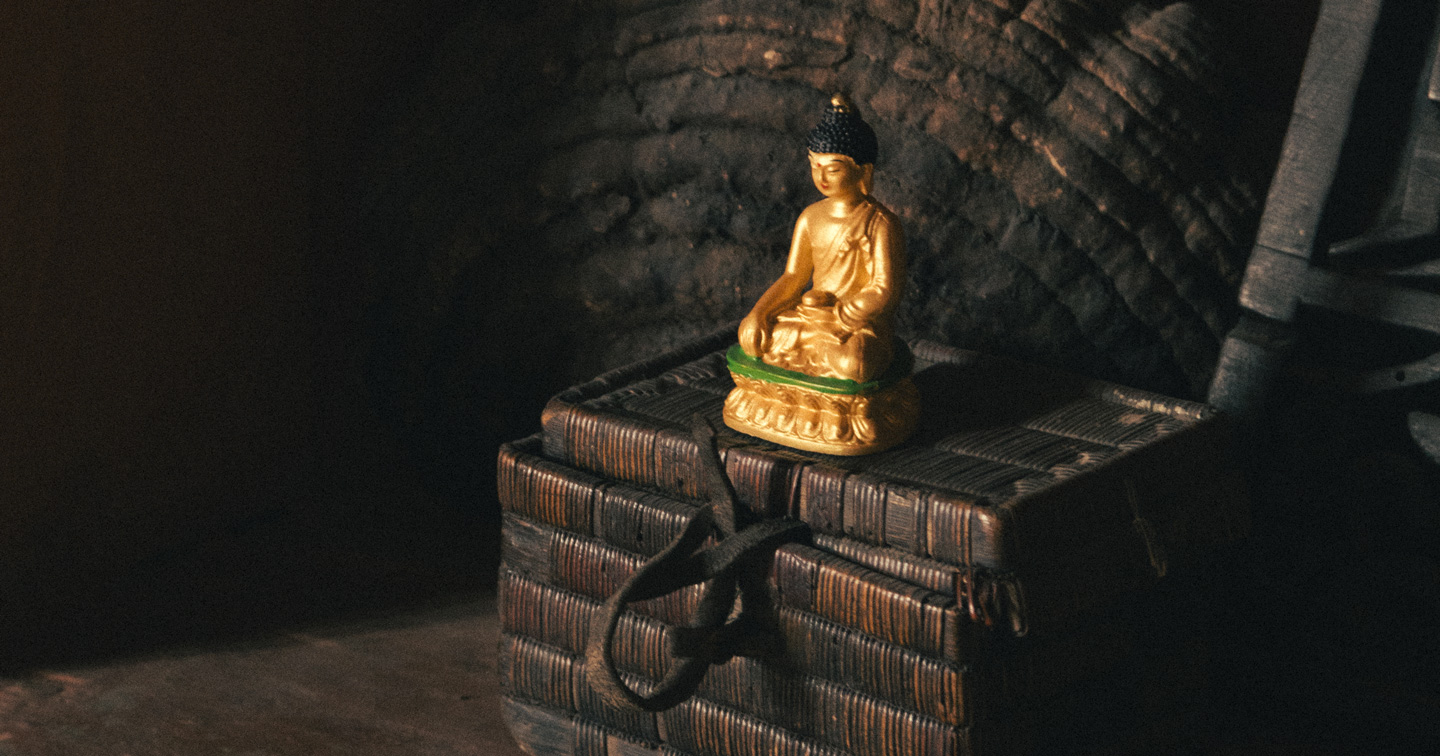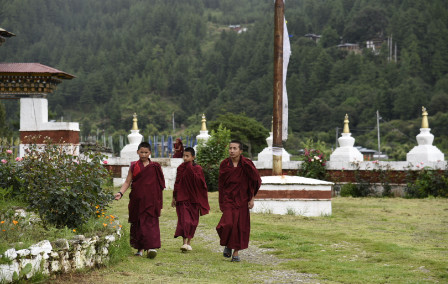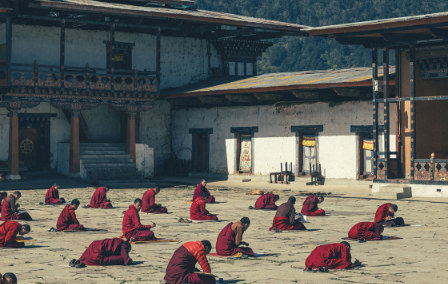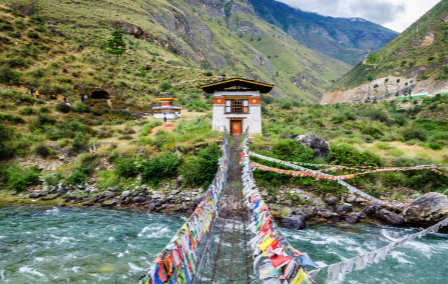Published 28th Jun. 2021
Reading time
This seven-storey structure is a welcome addition to the emerging kingdom's small capital city.
The elegant rooms - the smallest of which measure 450 square feet - are a haven, with high ceilings, dark-brown lacquered wood floors, walls mounted with mandalas, heated floors in bathrooms, and cushioned daybeds from which to gawk at the Himalayas.
Early-morning risers may catch sight of the monk who chants prayers in the outdoor courtyard, also where traditional dancers perform most nights around the sunken fire pit.
The restaurant's impressive Bhutanese menu includes a milky river-weed soup and ema-datshi, the national dish of melted cheese with grated chilies. Rimps, the lobby-level tea lounge with dramatic carved walls rising another four storeys, serves a tasty salted butter tea and offers a selection of authoritative reads on the region. Beneath the indoor pool is the aromatic Taj Spa.
Why We Love It
The hotel has access to one of the nation's seven nine-hole golf courses - His Majesty Jigme Singye Wangchuck is a keen golfer.
Amankora Bumthang is in exalted company, sharing the Choekhor Valley with 29 ancient temples and monasteries and sitting pretty next to the first two King of Bhutan's Wangdichholing Palace in Jakar town.
The old palace apple and pear orchards surround the Aman, and arrivals pass through a dzong (fortress monastery) style hallway before heading to one of 16 suites situated on two floors. Like in the other Amans, the suites have wood panelled interiors, traditional bukhari stoves, king size beds, terracco clad baths and daybeds.
There is a comfortable library and living room next to a courtyard that abuts the palace gardens and where guests can eat outside in the summer months. Otherwise meals are in opulent high ceilinged dining room. The spa has three treatment rooms and a steam room.
Away from the Aman there are several wonderful short treks to the many dzongs, temples and palaces in Bumthang, and also the Red Panda beer brewery - Bhutans' only one - to visit. Finally, and rather surreally, there are herds of Swiss cows nearby who make an excellent cheese and we can arrange a tasting.
Why We Love It
So close is Amankora Bumthang that access is through the palace sports grounds, so watch out for errant arrows from the archery range. Not that Bhutanese archers ever miss.
Named after nearby Gangtey village, this is probably the most remote of the Aman properties, situated in the Phobjikha Valley area of the Black Mountains National Park.
The rooms are in a similar style to those at Amankora Thimpu - minimalist, with the emphasis on dark wood interiors and large windows looking out over the valley and Gangtey Goemba, a 16th century monastery.
There is a dual use dining room and sitting room, and guests eat at a communal table that again look out over the valley. There is also a small spa, but this Aman is very much a base from which to explore this particularly fascinating part of Bhutan.
The Black Mountain National Park, normally inhabited by shepherds and nomadic yak herders, plays home each winter to a flock of 300 critically endangered black-necked cranes which fly in from Tibet. In seasons we can arrange for visits to see them, and also walks along Gangtey's many nature trails or even a spot of kite flying.
Why We Love It
Wildlife is superb around Amankora - In winter the best way to spot the reclusive black-necked cranes is from a viewing hide near their main feeding and nesting grounds.
While some of the other Aman properties are based on designs from dzong fortress monasteries, Amankora Punakha is a lovingly converted Bhutanese farmhouse, with a correspondingly intimate feel, and set in orange orchards and farmland with the ever-present mountains as a backdrop.
The eight minimalist suites have a similar design to those at Amankoras Paro and Bumthang, with bukharis (wood-burning stoves) to keep them warm in winter.
Away from the rooms the vegetable dye stained painted farmhouse is home to the dining room and on the top two floors a series of meditation and relaxation rooms. There is a courtyard where guests eat in the summer months, that is if the chef hasn't been called away to cook for the king, as happened while we were there.
There is also a Tea Pavilion and a Spa with treatment rooms, a steam room and yet another yoga/meditation room on the top floor with views over rice paddies.
Activities on offer include instruction in meditation techniques, visits to Punakha itself, once capital of Bhutan, and most importantly to the local dzong fortress monastery. This beautiful example is arguably the finest in the country, strategically built at the confluence of the mighty Phochu and Mochu Rivers.
Why We Love It
Amankora Punakha is reached across a suspension bridge over the Mo Chhu river where golf buggies are waiting to take you to what is, in our humble opinion, our favourite of the Bhutan Amans.
COMO Hotels have recently opened Uma by COMO, Punakha, a sister property to Uma Paro (or Uma by COMO, Paro as it's now supposed to be called. Catchy, no?)
Located 50 miles east of Bhutan's capital Thimphu, and at 4,000ft above sea level, Uma Punakha (sorry, we just can't do it) sits in the lush and tranquil Punakha Valley with panoramic views over the rolling terraced hills and Mo Chu River.
Designed along the same lines as its sister property, the new lodge features 11 elegant rooms with huge beds, wood-burning stoves and hand-painted murals on the walls portraying traditional Bhutanese scenes.
Guests can enjoy a range of activities including white-water rafting, hiking and cycling, as well as yoga and visits to the COMO Shambhala spa, which has traditional Bhutanese hot stone bath.
Meanwhile the open plan Bukhari bar and restaurant showcases the best in local, seasonal Bhutanese dishes.
COMO are offering special packages for guests looking to combine stays at the two properties, and also at the Bumdra Monastery Camp - the group's own wilderness campsite high in the Himalaya and accessed via remote mountain paths. Please ask us for more information on these combinations.
(Photos currently from Uma Paro - except the first - while we wait for professional photos of the new hotel)
Why We Love It
A short distance from the hotel is Punakha Dzong, the confluence of the Mo Chu River and a major tributary and an important religious site where the young King of Bhutan was recently married.
An excellent five-star hotel on a 38-acre site on a forested mountainside, close to the town of Paro, designed to respect local aesthetics while including modern comforts.
Most of the rooms and suites are housed in the main building, and many feature traditional hand-painted Bhutanese wall designs. There are also a few one-and-two-bedroomed villas in the surrounding pine forest, which have private spa treatment areas, personal butler service and panoramic views of the Paro Valley.
The Shambala Retreat spa offers a range of massages and Asian-inspired therapies, as well as a hot stone bath house and an indoor pool with an outdoor sundeck. There is also a gym and a yoga studio overlooking the Paro Valley.
The restaurant serves modern, light cuisine and the menus include local, organic produce such as butter, cheese, honey, red rice grown in the fields below.
Why We Love It
The hotel has one of just two indoor pools in Bhutan.
Within easy reach of the Bhutanese capital of Thimpu (population 80,000 - think Weston-super-Mare. Actually, don't) Amankora Thimpu is designed to resemble a dzong or fortress monastery.
The whitewashed stone property, surrounded by forests of blue pines, has 16 extremely comfortable suites similar to those at Amakora Gangtey, with dark wood interiors, large windows and lovely views into the woods. The spacious bathrooms provide terrazzo clad baths with views of the pine forest through a small vertical window.
The suites and a wood-clad and high ceilinged living/dining room sit around and overlooking a central courtyard and when the weather is good guests can eat outside on a terrace with views over the forests and a babbling stream. As if all this wasn't relaxing enough, there is a small spa with treatment rooms and a steam room.
Activities on offer include visits to Thimpu, a nearby dzong (fortress monastery) or a hidden monk village.
Why We Love It
Thimpu is great for its markets, museums and the King's spectacular dzong fortress. Also worth a peek nearby is the venerable 16th century Pangri Zampa, a school for trainee monk astrologers. Only in Bhutan.
The Happiest Place on Earth, otherwise known as Bhutan's colourful Kingdom, is soon to be playing host to Six Senses latest venture. Under the umbrella title of Six Senses Bhutan five separate and equally luxurious resorts are being created in Thimphu, Punakha, Gangtey, Bumthang and Paro - all set to open throughout 2019.
With just 82 suites and villas across Six Senses Bhutan the individual resorts will have exclusive and intimate atmospheres, each relevant to its unique location. The idea is that guests will travel between the various resorts in order to see and experience the varying landscapes, cultures and wonders of Bhutan.
Start in the cultural capital of Thimphu, move onto rural farmland in Punakha, then wildlife in Gangtey, lush forests in Bumthang and finally stone ruins at Paro. At each resort expect the natural landscape to dictate the design and décor in the hotel, with large windows and natural materials used throughout. For example, in the farming region of Punakha woven bamboo walls and mud brick in the bathrooms pays homage to the fertile landscapes surrounding the resort, which is set into and overlooking the terraces below. In Bumthang the resort is made up of wooden cabins set into the forest, all which feature timber walls and floors and use recycled wood to make lamp bases and tables.
Why We Love It
Combine the ease of staying in a series of luxurious hotels from one of our favourite hotel brands with the diversity and off-the-beaten track nature of Bhutan.

Exploring under-the-radar destinations can be difficult, but with the help of our passionate consultants, you’ll discover Bhutan like a local. With recent research trips under our belt, we have up-to-date knowledge of the best properties and experiences, from Punakha’s valleys to Paro’s peaks. Our expert guides and drivers will accompany you throughout your journey, allowing you to explore our personalised picks of hidden villages, mountainside monasteries and ancient wonders at your own pace.
ENQUIRE NOWPractical advice and inspiration for your next trip

We love championing under-the-radar countries, and our Asia specialist, Frances, took the road less travelled on a research trip to Bhutan. Far from the tourist bustle, Frances got stuck into Bhutanese traditions such as archery, stretched her legs on beautiful hikes and soaked sore muscles afterwards in heavenly hot stone baths. She left the country with a deep love for it and brimming with tips and tricks to elevate your stay.
14th August 2024 - Bhutan Travel Tips

Bhutan is a pioneer in sustainability. Not only was it the world’s first carbon-negative country, but this tiny Buddhist kingdom, nestled in the Himalayas between Tibet and India, is committed to the well-being of its civilians and environment above all else. Bhutan’s philosophy is based on Gross National Happiness (GNH), an index devised in the 1970s by the fourth king of Bhutan. Measuring 33 indicators including sustainable socio-economic development, cultural preservation and environmental conservation, it’s no wonder that Bhutan leads the charge in responsible tourism.
30th May 2024 - Bhutan Responsible Travel

With its dramatic landscapes that include everything from subtropical plains to steep mountains and valleys, Bhutan is a seriously dreamy destination when it comes to hiking holidays. And while the Bhutanese Himalayas may be home to the highest unclimbed mountain in the world, Gangkhar Puensum, there are a number of more accessible trails that criss-cross the stunning countryside and can be completed in a day.
12th November 2021 - Bhutan Adventure

Our team of destination experts will get to know you and your unique requirements for your holiday

We work with you to build an ultra-personalised holiday itinerary with your choice of accommodation, experiences and activities

All of our holidays include little extras designed to make a big difference to your trip, from fast-tracking you through airport check-in and security to our network of local Concierges